Climate-Induced Tree Growth Variations under the RCP 2.6 Scenario: A Case Study on the Southeastern Tibetan Plateau
Abstract
:1. Introduction
2. Data and Methods
2.1. Study Area
2.2. Climate Data
2.3. Tree-Ring Data
2.4. Analytical Methods
3. Results
3.1. Climate–Tree Growth Relationship
3.2. Climate-Induced Tree Growth Forecast
4. Discussion
5. Conclusions
Acknowledgments
Author Contributions
Conflicts of Interest
References
- Stocker, T.; Qin, D.; Plattner, G.; Tignor, M.; Allen, S.K.; Boschung, J.; Nauels, A.; Xia, Y.; Bex, V.; Midgley, P.M. Climate Change 2013: The Physical Science Basis; Cambridge University Press: Cambridge, UK; New York, NY, USA, 2014. [Google Scholar]
- Yan, L.; Liu, X. Has climatic warming over the Tibetan Plateau paused or continued in recent years. J. Earth Ocean Atmos. Sci. 2014, 1, 13–28. [Google Scholar]
- Linderholm, H.W. Growing season changes in the last century. Agric. For. Meteorol. 2006, 137, 1–14. [Google Scholar] [CrossRef]
- Ramsfield, T.D.; Bentz, B.J.; Faccoli, M.; Jactel, H.; Brockerhoff, E.G. Forest health in a changing world: Effects of globalization and climate change on forest insect and pathogen impacts. Forestry 2016, 89, 245–252. [Google Scholar] [CrossRef]
- Allen, C.D.; Macalady, A.K.; Chenchouni, H.; Bachelet, D.; McDowell, N.; Vennetier, M.; Kitzberger, T.; Rigling, A.; Breshears, D.D.; Hogg, E.T. A global overview of drought and heat-induced tree mortality reveals emerging climate change risks for forests. For. Ecol. Manag. 2010, 259, 660–684. [Google Scholar] [CrossRef]
- North, M.P.; Stephens, S.L.; Collins, B.M.; Agee, J.K.; Aplet, G.; Franklin, J.F.; Fulé, P.Z. Reform forest fire management. Science 2015, 349, 1280–1281. [Google Scholar] [CrossRef] [PubMed]
- Keenan, R.J. Climate change impacts and adaptation in forest management: A review. Ann. For. Sci. 2015, 72, 145–167. [Google Scholar] [CrossRef]
- Trumbore, S.; Brando, P.; Hartmann, H. Forest health and global change. Science 2015, 349, 814–818. [Google Scholar] [CrossRef] [PubMed]
- Fritts, H.C. Tree Rings and Climate; Academic Press: San Diego, CA, USA, 1976; 567p. [Google Scholar]
- Cook, E.R.; Kairiukstis, L.A. Methods of Dendrochronology: Applications in the Environmental Sciences; Springer: New York, NY, USA, 1990. [Google Scholar]
- Zhang, X.; Chen, Z. A new method to remove the tree growth trend based on ensemble empirical mode decomposition. Trees 2017, 31, 405–413. [Google Scholar] [CrossRef]
- Fan, Z.; Bräuning, A.; Cao, K. Annual temperature reconstruction in the Central Hengduan Mountains, China, as deduced from tree rings. Dendrochronologia 2008, 26, 97–107. [Google Scholar] [CrossRef]
- Zhang, X.; Yan, X.; Chen, Z. Reconstruct regional mean climate with Bayesian model averaging: A case study for temperature reconstruction in the Yunnan-Guizhou Plateau, China. J. Clim. 2016, 29, 5355–5361. [Google Scholar] [CrossRef]
- Fan, Z.; Bräuning, A.; Yang, B.; Cao, K. Tree ring density-based summer temperature reconstruction for the central Hengduan Mountains in southern China. Glob. Planet Chang. 2009, 65, 1–11. [Google Scholar] [CrossRef]
- Liang, E.Y.; Shao, X.M.; Xu, Y. Tree-ring evidence of recent abnormal warming on the southeast Tibetan Plateau. Theor. Appl. Climatol. 2009, 98, 9–18. [Google Scholar] [CrossRef]
- Yang, B.; Kang, X.C.; Bräuning, A.; Liu, J.; Qin, C.; Liu, J.J. A 622-year regional temperature history of southeast Tibet derived from tree rings. Holocene 2010, 20, 181–190. [Google Scholar] [CrossRef]
- Wang, J.; Bao, Y.; Qin, C.; Kang, S.; He, M.; Wang, Z. Tree-ring inferred annual mean temperature variations on the southeastern Tibetan Plateau during the last millennium and their relationships with the Atlantic Multidecadal Oscillation. Clim. Dynam. 2014, 43, 627–640. [Google Scholar] [CrossRef]
- Grotch, S.L.; Maccracken, M.C. The use of general circulation models to predict regional climatic change. J. Clim. 1991, 4, 286–303. [Google Scholar] [CrossRef]
- Gates, W.L. The use of general circulation models in the analysis of the ecosystem impacts of climatic change. Clim. Chang. 1985, 7, 267–284. [Google Scholar] [CrossRef]
- Robock, A.; Turco, R.P.; Harwell, M.A.; Ackerman, T.P.; Andressen, R.; Chang, H.S.; Sivakumar, M.V.K. Use of general circulation model output in the creation of climate change scenarios for impact analysis. Clim. Chang. 1993, 23, 293–335. [Google Scholar] [CrossRef]
- Vuuren, D.P.V.; Edmonds, J.; Kainuma, M.; Riahi, K.; Thomson, A.; Hibbard, K.; Hurtt, G.C.; Kram, T.; Krey, V.; Lamarque, J.F. The representative concentration pathways: An overview. Clim. Chang. 2011, 109, 5–31. [Google Scholar] [CrossRef]
- Meinshausen, M.; Smith, S.J.; Calvin, K.; Daniel, J.S.; Kainuma, M.L.T.; Lamarque, J.; Matsumoto, K.; Montzka, S.A.; Raper, S.C.B.; Riahi, K. The RCP greenhouse gas concentrations and their extensions from 1765 to 2300. Clim. Chang. 2011, 109, 213. [Google Scholar] [CrossRef]
- Zhang, X.; Yan, X.; Chen, Z. Geographic distribution of global climate zones under future scenarios. Int. J. Climatol. 2017. [Google Scholar] [CrossRef]
- Charney, N.D.; Babst, F.; Poulter, B.; Record, S.; Trouet, V.M.; Frank, D.; Enquist, B.J.; Evans, M.E.K. Observed forest sensitivity to climate implies large changes in 21st century North American forest growth. Ecol. Lett. 2016, 19, 1119–1128. [Google Scholar] [CrossRef] [PubMed]
- Dunckel, K.; Weiskittel, A.; Fiske, G. Projected future distribution of tsuga canadensis across alternative climate scenarios in Maine, US. Forests 2017, 8, 285. [Google Scholar] [CrossRef]
- Girardin, M.P.; Hogg, E.H.; Bernier, P.Y.; Kurz, W.A.; Guo, X.J.; Cyr, G. Negative impacts of high temperatures on growth of black spruce forests intensify with the anticipated climate warming. Glob. Chang. Biol. 2016, 22, 627–643. [Google Scholar] [CrossRef] [PubMed]
- Zhang, X.; Yan, X. Temporal change of climate zones in China in the context of climate warming. Theor. Appl. Climatol. 2014, 115, 167–175. [Google Scholar] [CrossRef]
- Zhang, X.; Yan, X. A novel method to improve temperature simulations of general circulation models based on ensemble empirical mode decomposition and its application to multi-model ensembles. Tellus A 2014, 66. [Google Scholar] [CrossRef] [Green Version]
- Zhang, X.; Xiong, Z.; Zhang, X.; Shi, Y.; Liu, J.; Shao, Q.; Yan, X. Using multi-model ensembles to improve the simulated effects of land use/cover change on temperature: A case study over northeast China. Clim. Dynam. 2016, 46, 765–778. [Google Scholar] [CrossRef]
- Grissinomayer, H.D.; Fritts, H.C. The international tree-ring data bank: An enhanced global database serving the global scientific community. Holocene 1997, 7, 235–238. [Google Scholar] [CrossRef]
- Melvin, T.M.; Briffa, K.R. A “signal-free” approach to dendroclimatic standardisation. Dendrochronologia 2008, 26, 71–86. [Google Scholar] [CrossRef]
- Biondi, F.; Waikul, K. DENDROCLIM2002: A C++ program for statistical calibration of climate signals in tree-ring chronologies. Comput. Geosci. 2004, 30, 303–311. [Google Scholar] [CrossRef]
- Gershunov, A.; Schneider, N.; Barnett, T. Low-frequency modulation of the Enso-Indian monsoon rainfall relationship: Signal or noise? J. Clim. 2001, 14, 2486–2492. [Google Scholar] [CrossRef]
- Frank, D.; Esper, J. Characterization and climate response patterns of a high-elevation, multi-species tree-ring network in the European Alps. Dendrochronologia 2005, 22, 107–121. [Google Scholar] [CrossRef]
- Büntgen, U.; Esper, J.; Frank, D.C.; Nicolussi, K.; Schmidhalter, M. A 1052-year tree-ring proxy for Alpine summer temperatures. Clim. Dynam. 2005, 25, 141–153. [Google Scholar] [CrossRef]
- Büntgen, U.; Frank, D.C.; Kaczka, R.J.; Verstege, A.; Zwijacz-Kozica, T.; Esper, J. Growth responses to climate in a multi-species tree-ring network in the Western Carpathian Tatra Mountains, Poland and Slovakia. Tree Physiol. 2007, 27, 689–702. [Google Scholar] [CrossRef] [PubMed]
- Salzer, M.W.; Bunn, A.G.; Graham, N.E.; Hughes, M.K. Five millennia of paleotemperature from tree-rings in the Great Basin, USA. Clim. Dynam. 2014, 42, 1517–1526. [Google Scholar] [CrossRef]
- Briffa, K.R.; Schweingruber, F.H.; Jones, P.D.; Osborn, T.J.; Shiyatov, S.G.; Vaganov, E.A. Reduced sensitivity of recent tree-growth to temperature at high northern latitudes. Nature 1998, 391, 678–682. [Google Scholar] [CrossRef]
- D’Arrigo, R.; Wilson, R.; Liepert, B.; Cherubini, P. On the ‘divergence problem’ in northern forests: A review of the tree-ring evidence and possible causes. Glob. Planet Chang. 2008, 60, 289–305. [Google Scholar] [CrossRef]
- Wilson, R.; D’Arrigo, R.; Buckley, B.; Büntgen, U.; Esper, J.; Frank, D.; Luckman, B.; Payette, S.; Vose, R.; Youngblut, D. A matter of divergence: Tracking recent warming at hemispheric scales using tree ring data. J. Geophys. Res. 2007, 112. [Google Scholar] [CrossRef]
- Büntgen, U.; Frank, D.; Wilson, R.; Carrer, M.; Urbinati, C.; Esper, J. Testing for tree-ring divergence in the European Alps. Glob. Chang. Biol. 2008, 14, 2443–2453. [Google Scholar] [CrossRef]
- Schneider, L.; Esper, J.; Timonen, M.; Büntgen, U. Detection and evaluation of an early divergence problem in northern Fennoscandian tree-ring data. Oikos 2014, 123, 559–566. [Google Scholar] [CrossRef]
- Carrer, M.; Urbinati, C. Age-dependent tree-ring growth responses to climate in Larix decidua and Pinus cembra. Ecology 2004, 85, 730–740. [Google Scholar] [CrossRef]
- Vieira, J.; Campelo, F.; Nabais, C. Age-dependent responses of tree-ring growth and intra-annual density fluctuations of Pinus pinaster to Mediterranean climate. Trees 2009, 23, 257–265. [Google Scholar] [CrossRef]
- Rozas, V.; DeSoto, L.; Olano, J.M. Sex-specific, age-dependent sensitivity of tree-ring growth to climate in the dioecious tree Juniperus thurifera. New Phytol. 2009, 182, 687–697. [Google Scholar] [CrossRef] [PubMed]
- Wang, X.; Zhang, Y.; McRae, D.J. Spatial and age-dependent tree-ring growth responses of Larix gmelinii to climate in northeastern China. Trees 2009, 23, 875–885. [Google Scholar] [CrossRef]
- Soja, A.J.; Tchebakova, N.M.; French, N.H.; Flannigan, M.D.; Shugart, H.H.; Stocks, B.J.; Sukhinin, A.I.; Parfenova, E.I.; Chapin, F.S.; Stackhouse, P.W. Climate-induced boreal forest change: Projections versus current observations. Glob. Planet Chang. 2007, 56, 274–296. [Google Scholar] [CrossRef]
- Salzer, M.W.; Hughes, M.K.; Bunn, A.G.; Kipfmueller, K.F. Recent unprecedented tree-ring growth in bristlecone pine at the highest elevations and possible causes. Proc. Natl. Acad. Sci. USA 2009, 106, 20348–20353. [Google Scholar] [CrossRef] [PubMed]
- McMahon, S.M.; Parker, G.G.; Miller, D.R. Evidence for a recent increase in forest growth. Proc. Natl. Acad. Sci. USA 2010, 107, 3611–3615. [Google Scholar] [CrossRef] [PubMed]
- Reich, P.B.; Luo, Y.; Bradford, J.B.; Poorter, H.; Perry, C.H.; Oleksyn, J. Temperature drives global patterns in forest biomass distribution in leaves, stems, and roots. Proc. Natl. Acad. Sci. USA 2014, 111, 13721–13726. [Google Scholar] [CrossRef] [PubMed]
- Rytter, L.; Ingerslev, M.; Kilpeläinen, A.; Torssonen, P.; Lazdina, D.; Löf, M.; Madsen, P.; Muiste, P.; Stener, L. Increased forest biomass production in the Nordic and Baltic countries—A review on current and future opportunities. Silva Fenn 2016, 50. [Google Scholar] [CrossRef]
- D’Orangeville, L.; Duchesne, L.; Houle, D.; Kneeshaw, D.; Côté, B.; Pederson, N. Northeastern North America as a potential refugium for boreal forests in a warming climate. Science 2016, 352, 1452–1455. [Google Scholar] [CrossRef] [PubMed]
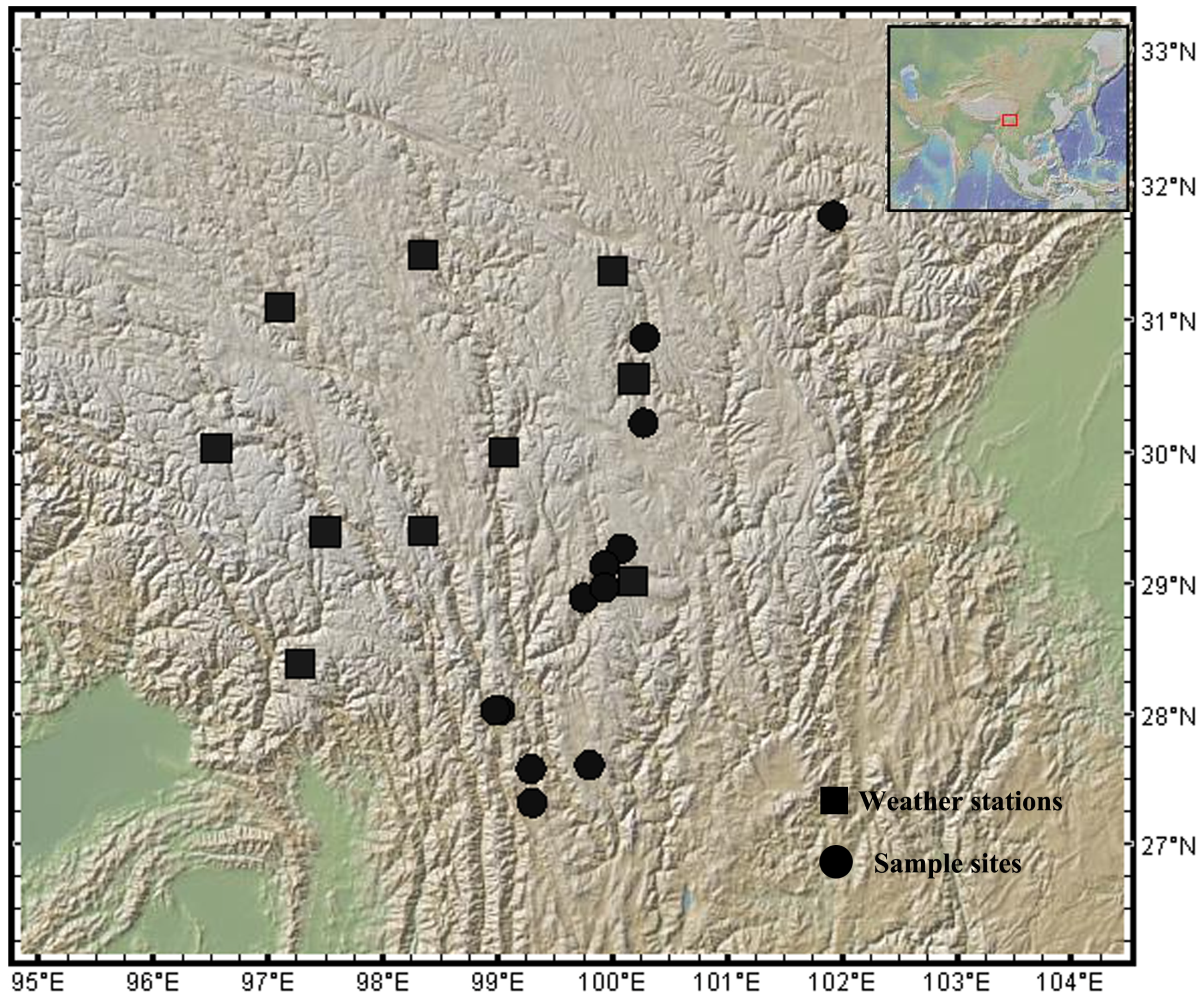
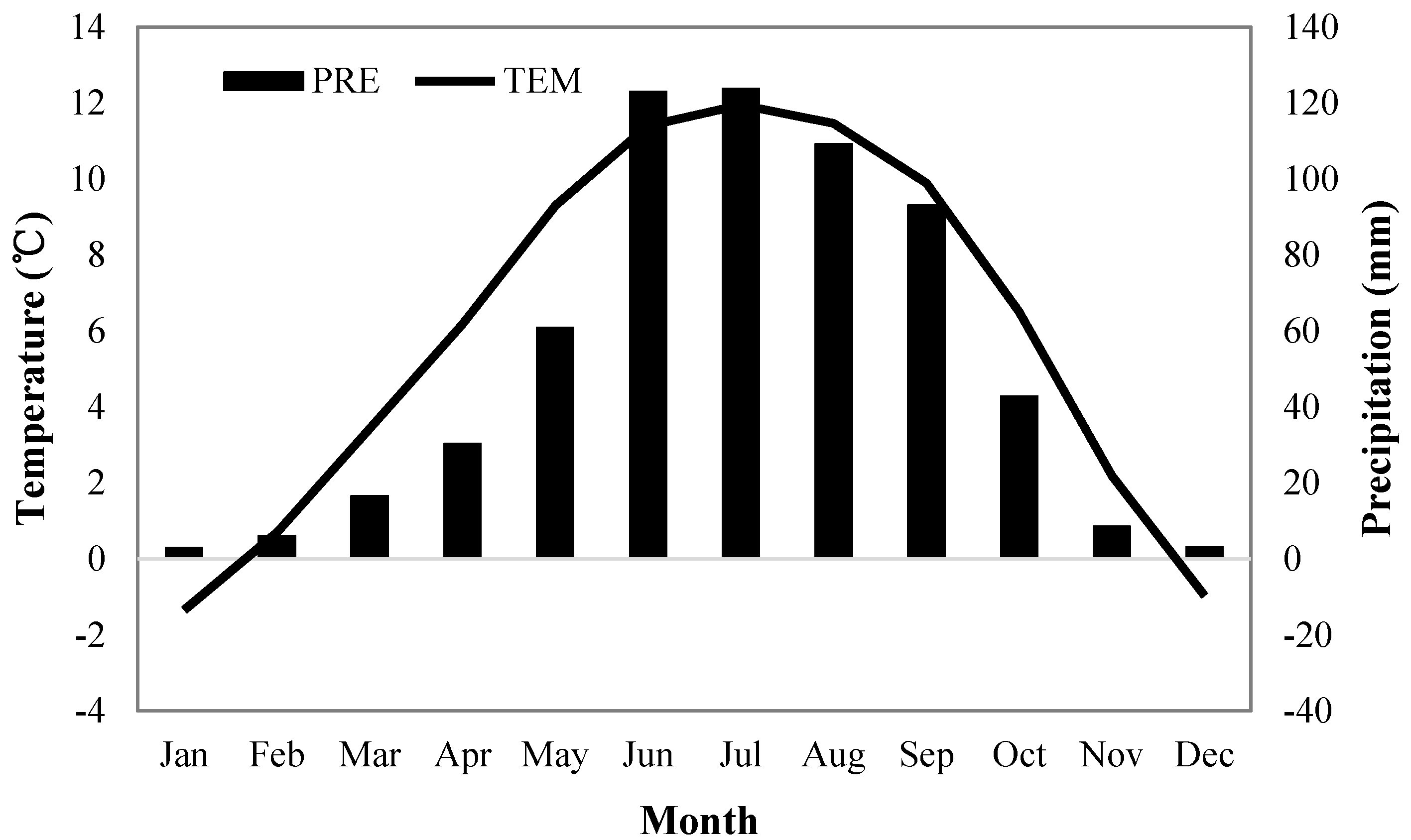
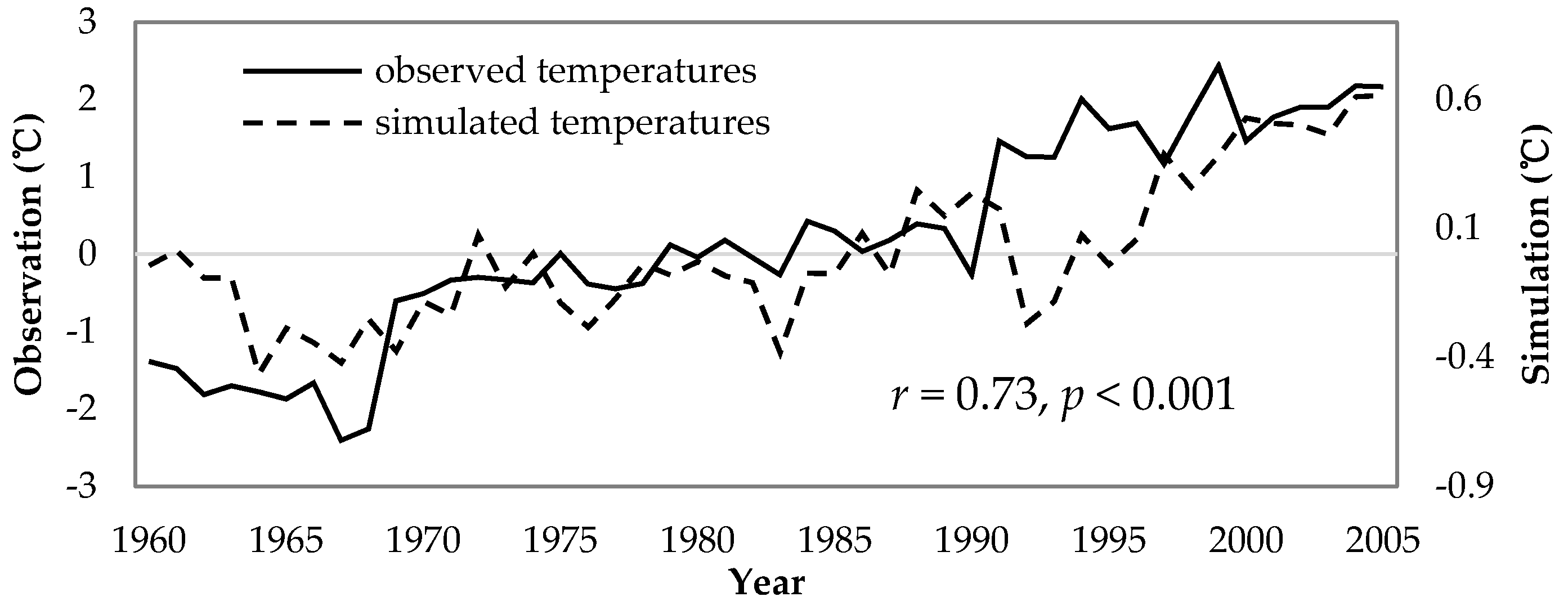

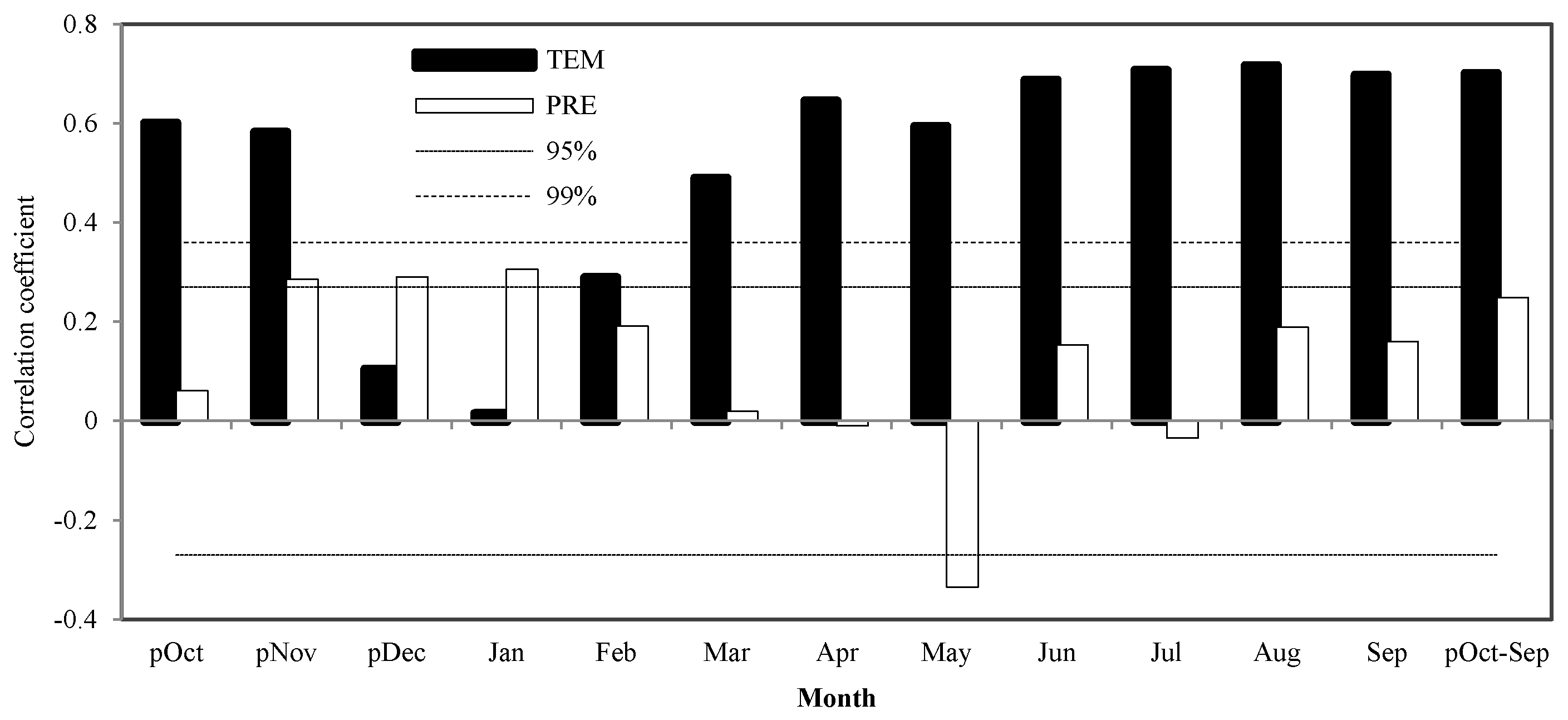

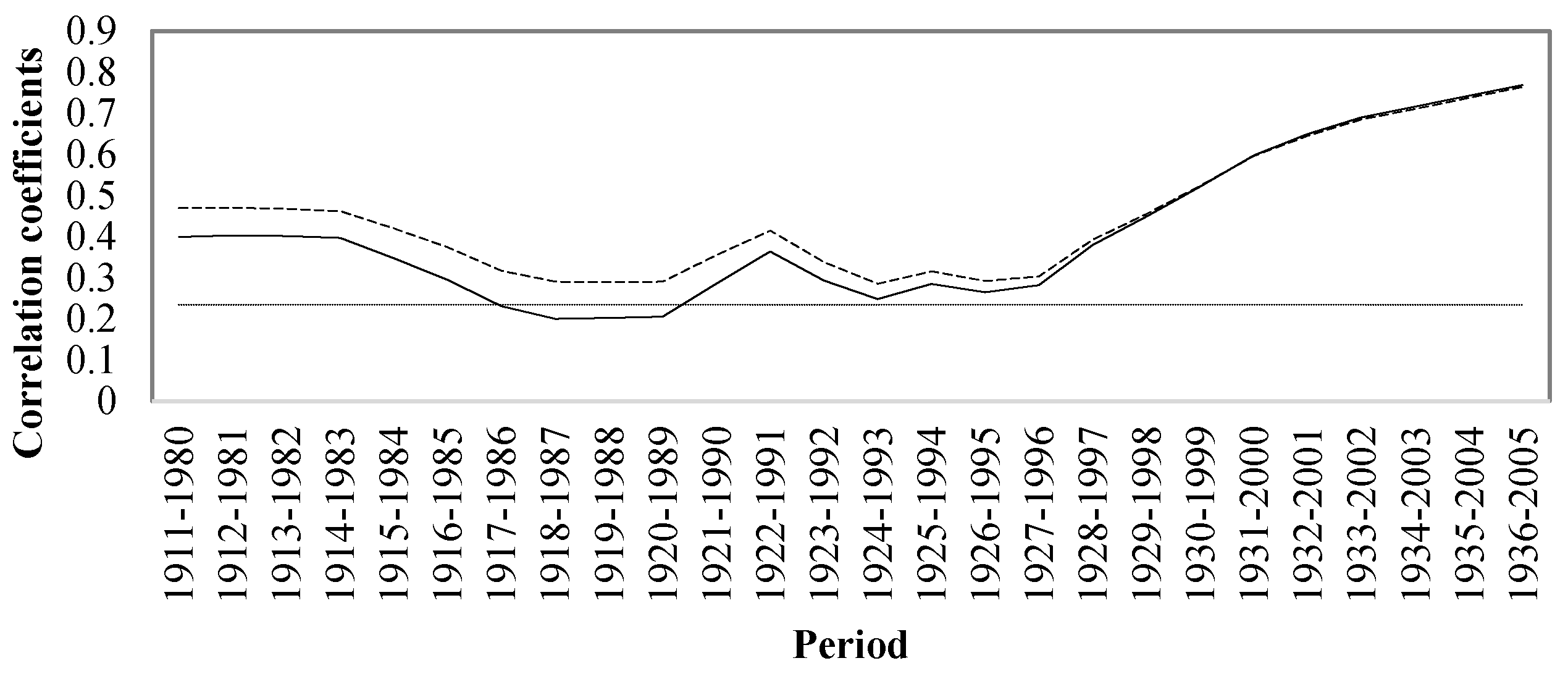
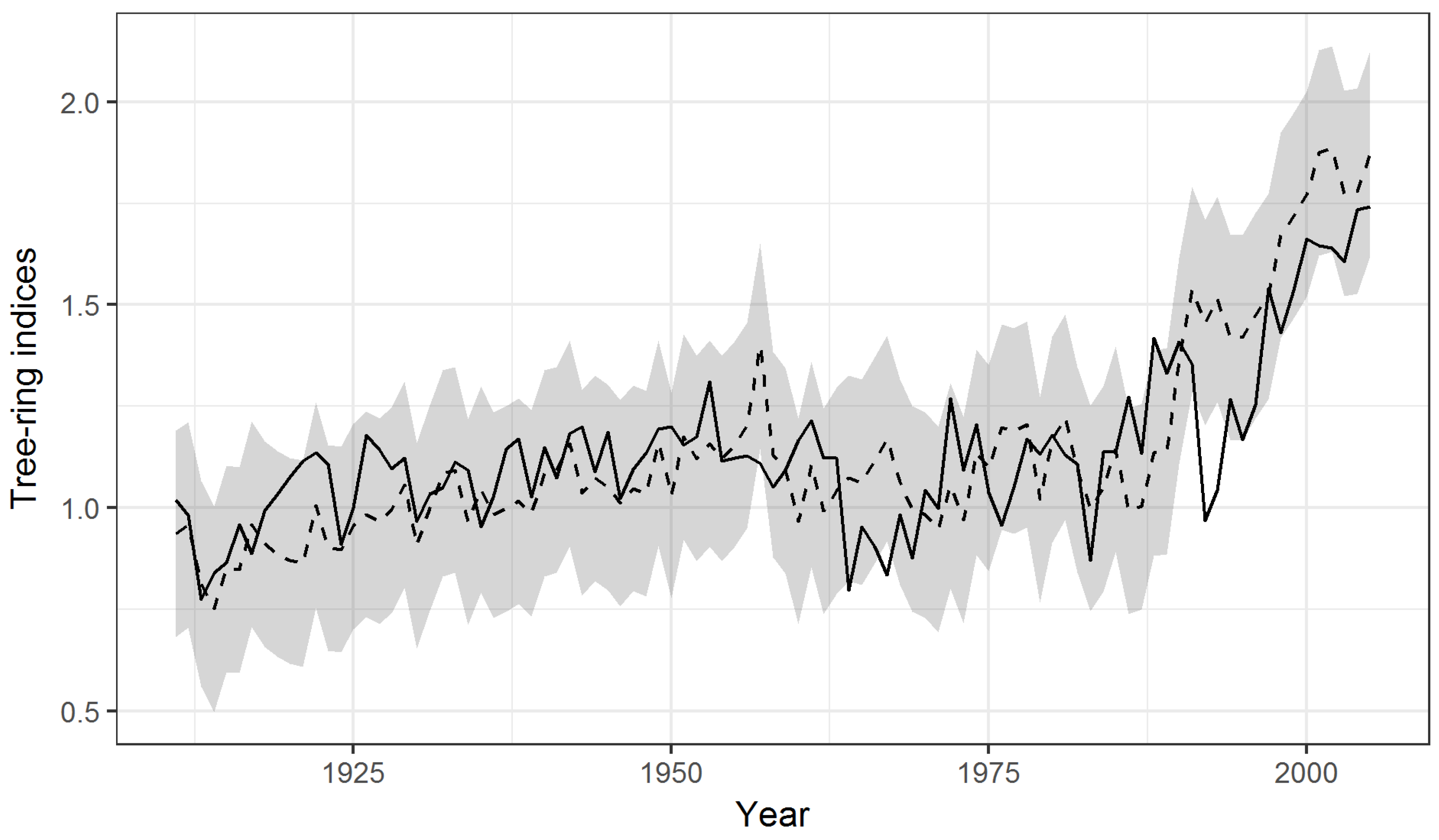


| Model Name | Atmospheric Resolution | Country/Institute |
|---|---|---|
| BCC-CSM1-1-m | 360 × 160 | China/Beijing Climate Center |
| BCC-CSM1-1 | 128 × 64 | China/Beijing Climate Center |
| BNU-ESM | 128 × 64 | China/Beijing Normal University |
| CanESM2 | 128 × 64 | Canada/Canadian Centre for Climate Modelling and Analysis |
| CCSM4 | 288 × 192 | USA/National Center for Atmospheric Research |
| CESM1-CAM5 | 288 × 192 | USA/National Center for Atmospheric Research |
| CNRM-CM5 | 256 × 128 | France/Centre National de Recherches Meteorologiques |
| CSIRO-Mk3-6-0 | 192 × 96 | Australia/Commonwealth Scientific and Industrial Research Organisation |
| EC-EARTH | 320 × 160 | EC-EARTH consortium |
| FGOALS-g2 | 128 × 60 | China/Institute of Atmospheric Physics |
| FIO-ESM | 128 × 64 | The First Institute of Oceanography, China |
| GFDL-CM3 | 144 × 90 | USA/Geophysical Fluid Dynamics Laboratory |
| GFDL-ESM2G | 144 × 90 | USA/Geophysical Fluid Dynamics Laboratory |
| GFDL-ESM2M | 144 × 90 | USA/Geophysical Fluid Dynamics Laboratory |
| GISS-E2-H | 144 × 90 | USA/NASA Goddard Institute for Space Studies |
| GISS-E2-R | 144 × 90 | USA/NASA Goddard Institute for Space Studies |
| HadGEM2-AO | 192 × 145 | UK/Met Office Hadley Centre |
| HadGEM2-ES | 192 × 145 | UK/Met Office Hadley Centre |
| IPSL-CM5A-LR | 96 × 96 | France/Institut Pierre-Simon Laplace |
| IPSL-CM5A-MR | 96 × 96 | France/Institut Pierre-Simon Laplace |
| MIROC5 | 256 × 128 | Japan/Atmosphere and Ocean Research Institute, National Institute for Environmental Studies, and Japan Agency for Marine-Earth Science and Technology |
| MIROC-ESM | 128 × 64 | Japan/Japan Agency for Marine-Earth Science and Technology, Atmosphere and Ocean Research Institute, and National Institute for Environmental Studies |
| MIROC-ESM-CHEM | 128 × 64 | Japan/Japan Agency for Marine-Earth Science and Technology, Atmosphere and Ocean Research Institute, and National Institute for Environmental Studies |
| MPI-ESM-LR | 192 × 96 | Germany/Max Planck Institute for Meteorology |
| MPI-ESM-MR | 192 × 96 | Germany/Max Planck Institute for Meteorology |
| MRI-CGCM3 | 320 × 160 | Japan/Meteorological Research Institute |
| NORESM1-M | 144 × 96 | Norway/Norwegian Climate Centre |
| NORESM1-ME | 144 × 96 | Norway/Norwegian Climate Centre |
| ID | Site Name | Latitude | Longitude | Elevation (m) | Species | Number of Series | Time Span |
|---|---|---|---|---|---|---|---|
| chin016 | Ma’Erkang | 31.78°N | 101.92 °E | 2500 | Cupressus chengiana | 40 | 1575–2007 |
| chin017 | Xiangcheng | 28.90°N | 99.75°E | 3980 | Juniperus tibetica | 43 | 1452–2007 |
| chin018 | Daocheng | 29.28°N | 100.08°E | 4150 | Cunninghamia lanceolata | 61 | 1540–2006 |
| chin019 | Xiangcheng | 29.15°N | 99.93°E | 3530 | Cunninghamia lanceolata | 56 | 1509–2006 |
| chin020 | Litang | 30.23°N | 100.27°E | 4050 | Juniperus tibetica | 44 | 1306–2007 |
| chin021 | Xiangcheng | 28.98°N | 99.93°E | 3750 | Cunninghamia lanceolata | 48 | 1380–2007 |
| chin022 | Xinlong County | 30.87°N | 100.28°E | 3300 | Picea likiangensis | 42 | 1663–2007 |
| chin026 | Shangri La | 27.62°N | 99.80°E | 3500 | Cunninghamia lanceolata | 67 | 1516–2007 |
| chin027 | Weixi County | 27.33°N | 99.3°E | 3040 | Cunninghamia lanceolata | 41 | 1348–2007 |
| chin028 | Weixi County | 27.33°N | 99.3°E | 3060 | Cunninghamia lanceolata | 43 | 1348–2007 |
| chin037 | Hengduan Mountains | 27.58°N | 99.35°E | 3240 | Picea likiangensis | 40 | 1429–2005 |
| chin039 | Hengduan Mountains | 28.04°N | 99.02°E | 3200 | Abies recurvata | 19 | 1489–2005 |
| chin040 | Hengduan Mountains | 28.04°N | 98.98°E | 3100 | Tsuga dumosa | 30 | 1393–2005 |
| Calibration (1911–1957) | Verification (1958–2005) | Calibration (1958–2005) | Verification (1911–1957) | Final Calibration (1911–2005) | |
|---|---|---|---|---|---|
| R | 0.637 | 0.789 | 0.789 | 0.637 | 0.791 |
| R2 | 40.5% | 62.2% | 62.2% | 40.5% | 62.6% |
| RE | - | 0.725 | - | 0.830 | - |
| CE | - | 0.515 | - | 0.055 | - |
© 2017 by the authors. Licensee MDPI, Basel, Switzerland. This article is an open access article distributed under the terms and conditions of the Creative Commons Attribution (CC BY) license (http://creativecommons.org/licenses/by/4.0/).
Share and Cite
Zhang, X.; Zou, F.; Chen, Z. Climate-Induced Tree Growth Variations under the RCP 2.6 Scenario: A Case Study on the Southeastern Tibetan Plateau. Forests 2017, 8, 359. https://doi.org/10.3390/f8100359
Zhang X, Zou F, Chen Z. Climate-Induced Tree Growth Variations under the RCP 2.6 Scenario: A Case Study on the Southeastern Tibetan Plateau. Forests. 2017; 8(10):359. https://doi.org/10.3390/f8100359
Chicago/Turabian StyleZhang, Xianliang, Fenghua Zou, and Zhenju Chen. 2017. "Climate-Induced Tree Growth Variations under the RCP 2.6 Scenario: A Case Study on the Southeastern Tibetan Plateau" Forests 8, no. 10: 359. https://doi.org/10.3390/f8100359





